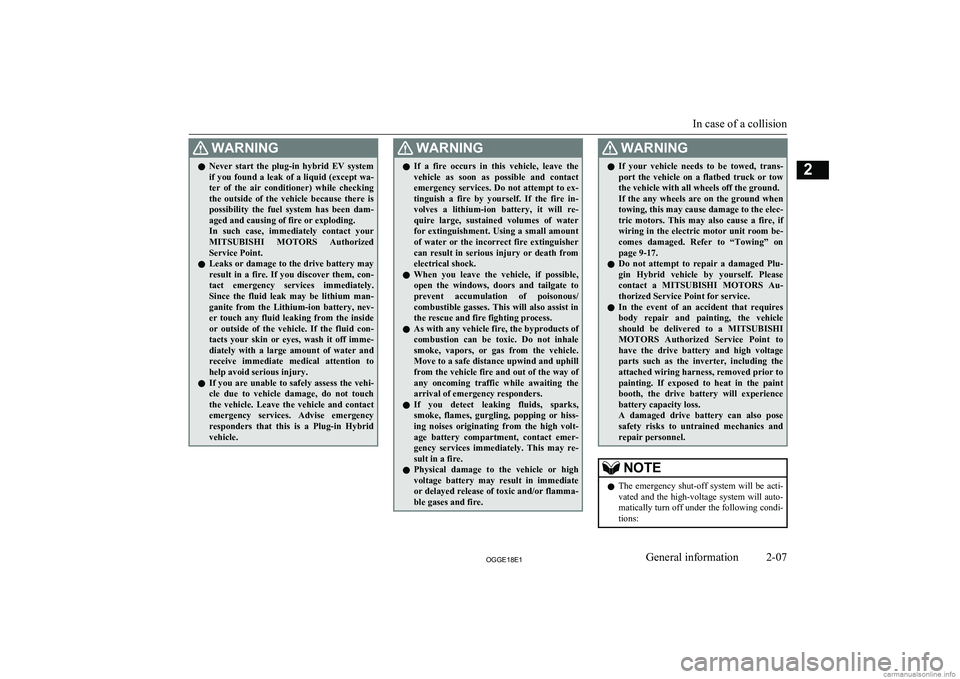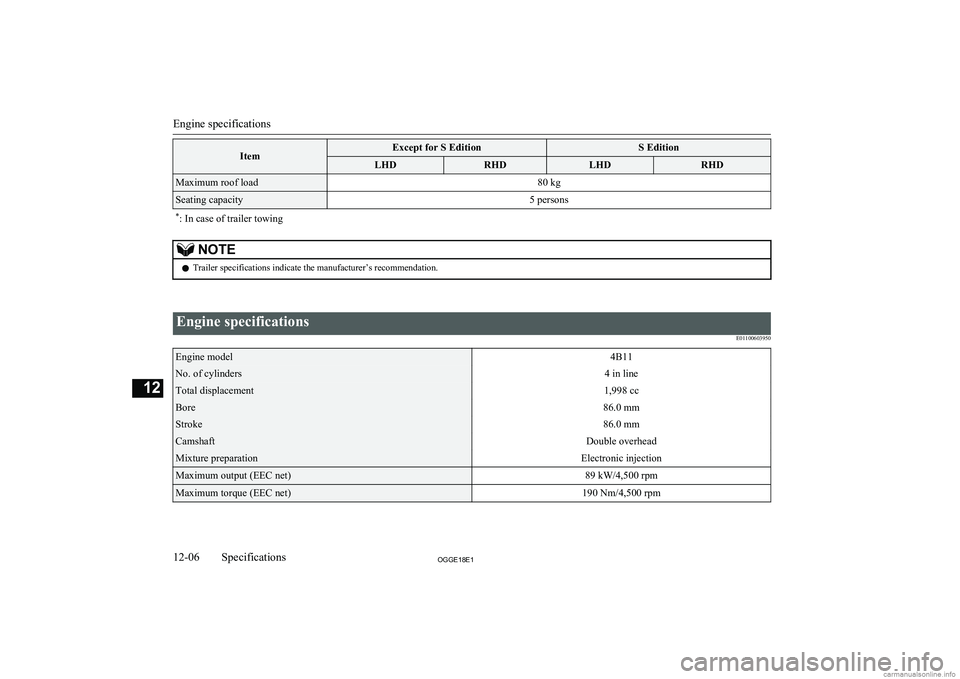2018 MITSUBISHI OUTLANDER PHEV towing capacity
[x] Cancel search: towing capacityPage 31 of 538

WARNINGlNever start the plug-in hybrid EV system
if you found a leak of a liquid (except wa-
ter of the air conditioner) while checking the outside of the vehicle because there is
possibility the fuel system has been dam- aged and causing of fire or exploding.
In such case, immediately contact your
MITSUBISHI MOTORS Authorized
Service Point.
l Leaks or damage to the drive battery may
result in a fire. If you discover them, con-
tact emergency services immediately.
Since the fluid leak may be lithium man- ganite from the Lithium-ion battery, nev- er touch any fluid leaking from the inside
or outside of the vehicle. If the fluid con- tacts your skin or eyes, wash it off imme-
diately with a large amount of water and receive immediate medical attention to
help avoid serious injury.
l If you are unable to safely assess the vehi-
cle due to vehicle damage, do not touch the vehicle. Leave the vehicle and contact
emergency services. Advise emergency responders that this is a Plug-in Hybrid
vehicle.WARNINGl If a fire occurs in this vehicle, leave the
vehicle as soon as possible and contact
emergency services. Do not attempt to ex- tinguish a fire by yourself. If the fire in-
volves a lithium-ion battery, it will re- quire large, sustained volumes of water for extinguishment. Using a small amount
of water or the incorrect fire extinguisher
can result in serious injury or death from electrical shock.
l When you leave the vehicle, if possible,
open the windows, doors and tailgate to
prevent accumulation of poisonous/ combustible gasses. This will also assist in
the rescue and fire fighting process.
l As with any vehicle fire, the byproducts of
combustion can be toxic. Do not inhale
smoke, vapors, or gas from the vehicle. Move to a safe distance upwind and uphill
from the vehicle fire and out of the way of any oncoming traffic while awaiting the
arrival of emergency responders.
l If you detect leaking fluids, sparks,
smoke, flames, gurgling, popping or hiss-
ing noises originating from the high volt- age battery compartment, contact emer-
gency services immediately. This may re- sult in a fire.
l Physical damage to the vehicle or high
voltage battery may result in immediate or delayed release of toxic and/or flamma- ble gases and fire.WARNINGl If your vehicle needs to be towed, trans-
port the vehicle on a flatbed truck or tow
the vehicle with all wheels off the ground.
If the any wheels are on the ground when towing, this may cause damage to the elec-
tric motors. This may also cause a fire, if
wiring in the electric motor unit room be- comes damaged. Refer to “Towing” on
page 9-17.
l Do not attempt to repair a damaged Plu-
gin Hybrid vehicle by yourself. Please contact a MITSUBISHI MOTORS Au-
thorized Service Point for service.
l In the event of an accident that requires
body repair and painting, the vehicle should be delivered to a MITSUBISHI
MOTORS Authorized Service Point to
have the drive battery and high voltage parts such as the inverter, including the
attached wiring harness, removed prior to
painting. If exposed to heat in the paint booth, the drive battery will experiencebattery capacity loss.
A damaged drive battery can also pose
safety risks to untrained mechanics and
repair personnel.NOTEl The emergency shut-off system will be acti-
vated and the high-voltage system will auto- matically turn off under the following condi-
tions:
In case of a collision
2-07OGGE18E1General information2
Page 242 of 538

Battery charge mode switchE00636900081
It can be used when increasing the remaining quantity of the drive battery.
Use the battery charge mode switch before
driving at long up hills, such as mountains with a steep slope.
By charging the drive battery before driving, it becomes possible to continue hill-climbing
performance (driving force).
If the battery charge mode switch is pressed while the ready indicator is on, the engine
will start and it can charge the drive battery
to near the full charge during the vehicle is run and stopped.
It can be cancelled if pressed once again.
If the battery charge mode is activated, the
following image is displayed on the informa-
tion screen in the multi-information display.
WARNINGl When you leave the vehicle, be sure that
you have stopped the Plug-in Hybrid EV
System. Refer to “Parking” on page 7-06.
l Only use the battery charge mode in a
well ventilated space.
The engine will start when the vehicle is in
the battery charge mode, and this can
cause carbon monoxide to build up caus- ing carbon monoxide poisoning. Be sure
to use at the well-ventilated place.
l Do not use the battery charge mode near
flammable objects such as dried grass or
paper etc. There is a possibility of starting a fire due to the high exhaust pipe tem-
perature.CAUTIONl While the battery charge mode is activated,
do not cover the front of the vehicle withanything including a car cover. Doing so
could cause the engine to overheat.NOTEl Use the battery charge mode switch before
the uphill climb.
l Even if the battery charge mode switch is
pressed, the engine may not start dependingon the condition of the remaining drive bat-
tery capacity or the Plug-in Hybrid EV sys- tem control.
Additionally, the battery charge mode may
not be activated depending on the remaining fuel quantity.
l It is recommended to use the battery charge
mode switch at least 20 minutes before youclimb, in order to continue a speed of more
than 100 km/h (62 mph), or when a long slope (gradient of more than 4 %) is expec-
ted. (According to a towing weight, it may not be able to continue the speed.)
l When using the battery charge switch with a
vehicle that has stopped in the heath a long
time, it may not charge.
l The charging time close to full charge of the
drive battery becomes longer depending on the condition of the drive battery, a driving
condition or a environment.
l The engine may stop near full charge.
l If you press the battery charge switch in or-
der to generate electricity while using gaso-
line, the fuel consumption will suffer.
We recommend you to consider the environ- ment.
Battery charge mode switch
7-28OGGE18E1Starting and driving7
Page 484 of 538

ItemExcept for S EditionS EditionLHDRHDLHDRHDMaximum roof load80 kgSeating capacity5 persons*: In case of trailer towingNOTEl Trailer specifications indicate the manufacturer’s recommendation.
Engine specifications
E01100603950Engine model4B11No. of cylinders4 in lineTotal displacement1,998 ccBore86.0 mmStroke86.0 mmCamshaftDouble overheadMixture preparationElectronic injectionMaximum output (EEC net)89 kW/4,500 rpmMaximum torque (EEC net)190 Nm/4,500 rpm
Engine specifications
12-06OGGE18E1Specifications12
Page 495 of 538

Towing.............................................................. 9-17
Trailer towing.................................................. 7-116
Transaxle fluid ................................................12-10
Turn-signal indication lamps.............................6-47
Turn/Lane-change signals................................. 6-60
Tyre pressure monitoring system (TPMS)........ 7-89
Tyre repair kit.................................................... 9-07
Tyres................................................................ 11-10 How to change a tyre.................................... 9-13
Inflation pressures....................................... 11-10
Rotation....................................................... 11-11
Size (tyre and wheel).................................. 12-08
Snow traction device (tyre chains).............. 11-13
Snow tyres................................................... 11-12
Tread wear indicators.................................. 11-11
Tyre pressure monitoring system (TPMS).. 11-10
Tyre repair kit............................................... 9-07
U
Ultrasonic misacceleration MitigationSystem (UMS)................................................. 7-74
USB input terminal............................................8-69 How to connect a USB memory................... 8-69
How to connect an iPod................................ 8-70
V
Vanity mirror lampBulb capacity.............................................. 11-25
Vehicle care precautions................................. 10-02
Vehicle dimensions......................................... 12-04
Vehicle identification number......................... 12-02
Vehicle identification number plate................ 12-02
Vehicle information code plate....................... 12-02
Vehicle labeling...............................................12-02
Vehicle performance....................................... 12-05
Vehicle weight.................................................12-05
Ventilators......................................................... 8-02
W
Warning lamps.................................................. 6-48
Washer Fluid.................................................. 11-08,12-10
Switch................................................... 6-65,6-66
Washing...........................................................10-03
Waxing............................................................ 10-04
Weight............................................................. 12-05
Wheel Specification............................................... 12-08
Wiper de-icer switch......................................... 6-67
Wiper Rear window................................................. 6-65Windscreen................................................... 6-62
Wiper blades............................................... 11-13
Alphabetical index
13- 5
OGGE18E1Alphabetical index